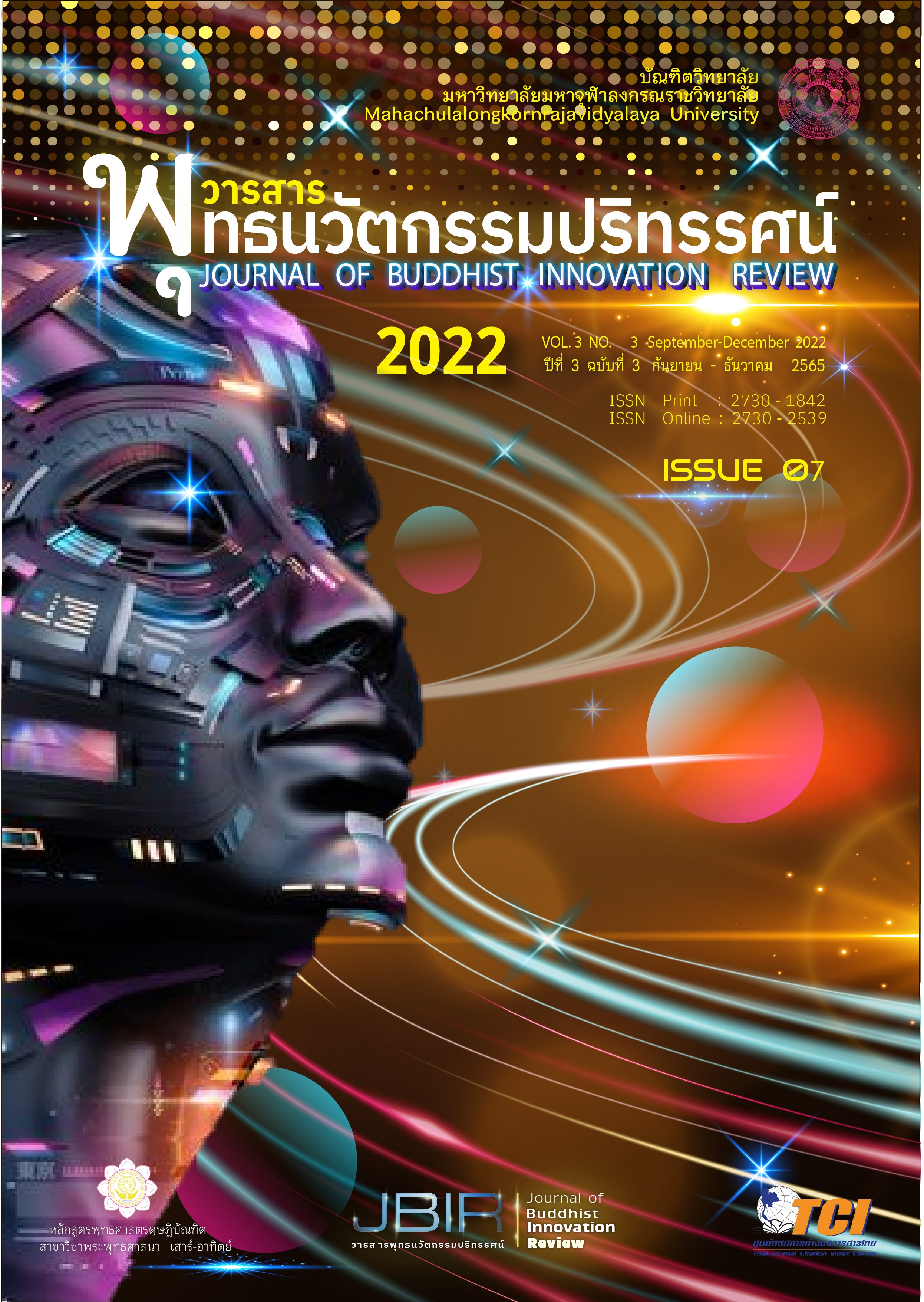Wisdom "A tool for making wisdom cheerful.
Main Article Content
Abstract
Intellectual development aims to benefit oneself and others. Teach human beings to be freed from the changing situation of ethics in today's world. Wisdom, the “tool for enlightenment,” is the nature of knowing clearly, enlightening, knowing the truth, knowing all, profound knowledge, distinguishing good and evil, knowing sin and virtue. blame Know the benefits that will occur know the punishment that has been committed know the cause, know the effect and analyze what should be done and what should not be done, which is the basis for a basic understanding that is the starting point To lead to the development of wisdom at a higher level, namely, global wisdom, which is the wisdom thatarises from listening and thinking. As for the wisdom in the worldly wisdom, it is the wisdom that arises from the development of introspection, the wisdom at the lokiya level, the wisdom that is still born in the various worlds, the wisdom in the worldly wisdom is the wisdom that Completely eradicate defilements, which is the ultimate goal in Buddhism. which the use of wisdom or trisikkha to solve the problems of Buddhists' lives in Thai society.
Article Details

This work is licensed under a Creative Commons Attribution-NonCommercial-NoDerivatives 4.0 International License.
เรื่องลิขสิทธิ์/เป็นความคิดเห็นของผู้เขียน
References
เอกสารอ้างอิง
หนังสือ
มหาวิทยาลัยมหาจุฬาลงกรณราชวิทยาลัย, (2539). พระไตรปิฎกภาษาไทย. ฉบับมหาจุฬาลงกรณราชวิทยาลัย กรุงเทพมหานคร: โรงพิมพ์มหาจุฬาลงกรณราชวิทยาลัย.
มหาวิทยาลัยมหาจุฬาลงกรณราชวิทยาลัย, (2539). อรรถกถาภาษาไทย. ฉบับมหาจุฬาลงกรณราชวิทยาลัย. กรุงเทพมหานคร: โรงพิมพ์มหาจุฬาลงกรณราชวิทยาลัย.
พระธรรมปิฎก (ป.อ.ปยุตฺโต), (2540).เมื่อสุขแท้ก็ถึงธรรม.กรุงเทพมหานคร: ธรรมสภา. พระพรหมคุณาภรณ์ (ป.อ.ปยุตฺโต), (2532).ทุกข์สําหรับเห็นแต่สุขสําหรับเป็น. พิมพ์ครั้งที่ 18. กรุงเทพมหานคร: โรงพิมพ์สหธรรมิก.
อดิศักดิ์ ทองบุญ,(2532).ปรัชญาอินเดีย.กรุงเทพมหานคร: อัมรินทร์พริ้นต้ิงกรุ๊ป.
ทองย้อย แสงสินชัย,(2557).บาลีวันละคํา. กรุงเทพมหานคร: สํานักพิมพ์นานมีบุ๊คส์พับลิเคชั่น. พระพุทธทาสภิกข,ุ(2549).คู่มือมนุษย์.กรุงเทพมหานคร:สํานักพิมพส์ุขภาพใจ.
พระพรหมคุณาภรณ์ (ป.อ.ปยุตฺโต), (2554).การเสริมสร้างคุณลักษณะเด็กไทย. พิมพ์ครั้งที่ 2. กรุงเทพมหานคร: โรงเพิมพ์พระพุทธศาสนาของธรรมสภา.
พระธรรมโกศาจารย์ (ประยูร ธมฺมจิตฺโต),(2551). สัมโมทนียกถา ในงานวันจํานงค์ ทองประเสริฐ ครั้งที่ 5 2 พฤษภาคม 2550. พิมพ์ครั้งท่ี 1. กรุงเทพมหานคร: โรงพิมพ์มหาจุฬาลงกรณราชวิทยาลัย.
จํานงค์ ทองประเสริฐ, (2533).ปรัชญาตะวันตกสมัยโบราณ. พิมพ์ครั้งที่ 7, กรุงเทพมหานคร: สํานักพิมพ์มหาจุฬาลงกรณราชวิทยาลัย.
ส่ืออิเล็กทรอนิกส์
พระธรรมวัชรบัณฑิต,ศ.ดร.(2565).[ออนไลน์].เรียนรู้ปัญหาด้วยสิติปัญญา. จาก https://www.youtube.com. [สืบค้นเมื่อวันที่ 10 ตุลาคม 2565].
พระธรรมปิฎก(ป.อ.ปยุตโต)(2558).[ออนไลน]์. ชีวิตที่สร้างสรรค์สดใสและสุขสันต์. จากhttp:// www. watkaokrailas.com. [สืบค้นเมื่อวันที่ 10 ตุลาคม 2565]
พุทธทาสภิกขุ. (2565). [ออนไลน์] อารัมภกถาเก่ียวกับพระพุทธองค์ พระพุทธคุณบรรยาย (น.2). จากhttps:// www.pagoda.or.th/general. [สืบค้น เมื่อวันที่ 10 ตุลาคม 2565].
ไชย ณ พล.(2565).[ออนไลน์]. ธรรมกระจ่าง. จาก www. uttayarndham.org/dhamma-sharing. [สืบค้นเมื่อวันที่10 ตุลาคม 2565]
หลวงพ่อปราโมทย์ ปาโมชฺโช.(2562). [ออนไลน์]. อ่านธรรมคําสอน วดั สวนสันติธรรม. จ า ก https://www.facebook.com/TimelyDhamma. [สืบค้นเมื่อวันท่ี 10 ต ุ ล า ค ม 2 5 6 5 ].
เว็บบอร์ดธรรมะไทย.(2562).[ออนไลน์] สนธนาธรรม – ปัญหาธรรมะ.จาก http://www.dhammathai.org/webboard/dbview.php?No=259. [สืบค้นเมื่อวันท่ี 10 ต ุ ล า ค ม 2 5 6 5 ].


